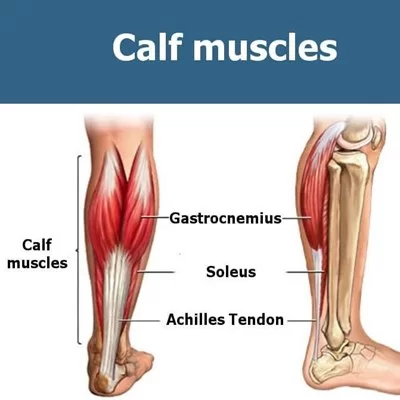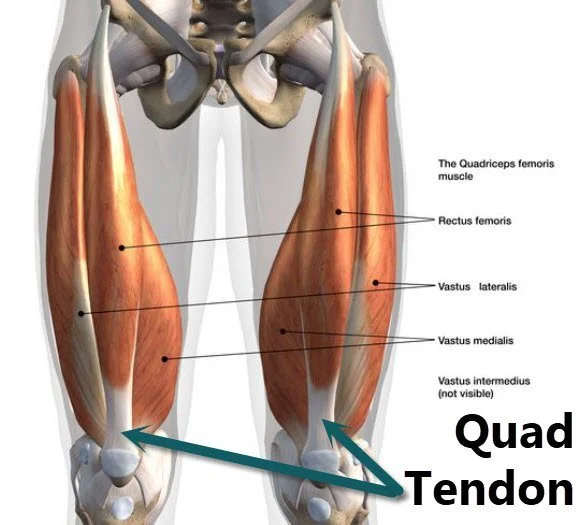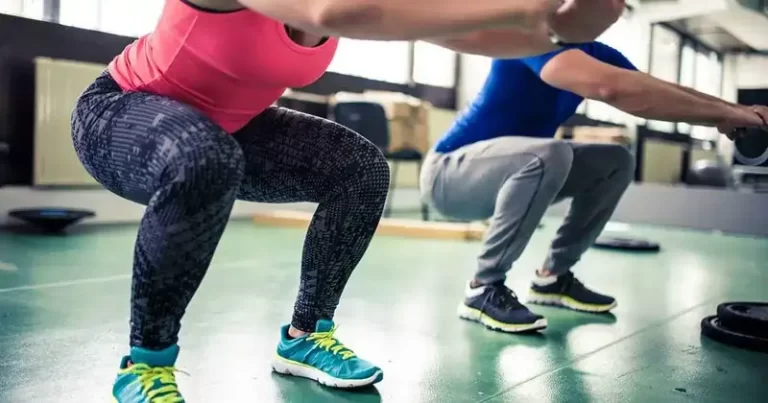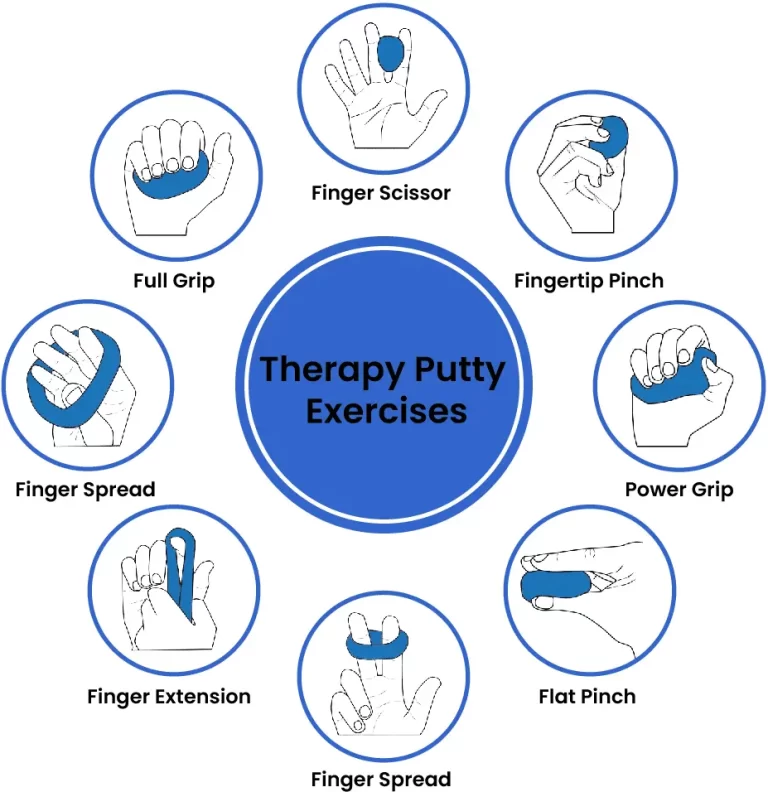18 Best Exercises for Runner’s Knee
Exercises for Runner’s Knee are an important part of your total treatment plan since they help to strengthen your leg muscles, improve flexibility, and increase overall stamina.
Athletes frequently experience a runner’s knee. It’s not something to worry about. Actually, by being active in treating the condition with exercise, you can avoid the runner’s knee.
To relieve the runner’s knee pain, try a variety of exercises that focus on supporting the hips and knees. Additionally, you could strengthen your hip flexors and hamstrings.
Physical therapy is the most common treatment for a runner’s knee. Physical therapy can help with posture and joint mobility so you can participate in regular activities with minimum pain. Strengthening activities can relieve tense muscles, maintain knee support when jogging, and maintain leg flexibility.
What is a runner’s knee?
Runner’s knee is referred to as patellofemoral pain syndrome (PFPS). It happens when the knee’s soft tissues, which include the knee joint’s protective synovial tissue, fat pads, and patellar tendon, get irritated.
Patellofemoral syndrome is a condition that can produce dull pain in the region around the kneecap and at the front of the knee. It is typical for bikers, runners, and individuals who engage in more jumping-intensive sports. the runner’s knee may be relieved with rest and the application of ice. You can perform strengthening and stretching exercises at home.
Continue reading to learn more about exercises and other alternative natural cures. After a few weeks of at-home treatment, see a doctor if the pain gets worse or does not get better.
What causes the runner’s knee?
Inflammation of the knee’s soft tissues or lining, strained tendons, or worn or torn cartilage can all contribute to the pain associated with a runner’s knee.
Additionally, a runner’s knee can be caused by any of the following:
- Excessive use
- Damage or misalignment of the kneecap
- Complete or partial dislocation of the kneecap
- Flat feet
- Weak thigh muscles
- Not stretching enough before working out arthritis
- Synovial plica syndrome, another name for broken kneecap plica syndrome, is characterized by stiffness and inflammation of the joint lining.
What signs and symptoms indicate a runner’s knee?
Pain at the front, behind, or surrounding the kneecap is the sign of a runner’s knee. Whether dull or achy, the pain usually gets worse when you move for example, when you run, walk, climb stairs, squat, kneel, or spend a lot of time sitting with your knee bent.
Runner’s knee symptoms and signs:
- Swelling in the kneecap area
- The sensation of something irritating, crushing, or breaking in the knee
- Instability or weakness in the knee
- Knee pain when bending or straightening
Does physical activity work well to treat a runner’s knee?
Most people get well with the help of rehabilitation exercises and stretches. Three times a week for six weeks, a set of hip- and knee-strengthening exercises should be done to improve physical training and reduce knee pain.
Furthermore, using specific physical therapy exercises to strengthen the quadriceps and promote flexibility proved to be more helpful than using knee braces or knee tape. Also, there are situations in which strengthening exercises could be more advantageous than using Painkillers.
Depending on your issue, a physical therapist can help you choose which exercises are more beneficial for you. They might help you in locating stretches and exercises that focus on particular areas. If you want correction for a muscular imbalance, they can even follow.
Take the following steps before starting an exercise therapy:
Before beginning any exercise program, make sure you follow a few safety measures and get the most of the benefits. Consult a physician or physical therapist for advice on which are suitable workouts for your specific problem.
It’s important to listen to your body and avoid pushing above your comfort level. While soreness following exercise is normal, persistent or severe pain may indicate that you’re pushing yourself too hard. Your best option is to start with low-impact workouts and work your way up to more challenging ones as soon as you can.
To avoid further injuries, it’s important to maintain proper technique and posture. If you’re unsure about how to properly complete your exercise therapy, consult a physical therapist. Before starting any exercise, warm up your muscles and joints so you can help them prepare for the task.
Exercises for Runner’s Knee:
These exercises are simply ideas that may help your knee; a physical therapist can give you a correct diagnosis, identify the origin of your runner’s knee, and create the best plan of care for your pain.
Straight Leg Raises
- Lying on your back.
- Keeping one leg at a 90-degree angle at the knee.
- Gradually raise the leg.
- Hold this position for a few seconds.
- Lower the leg to the floor gradually.
- Then return to your neutral position.
- Then relax.
- Repeat this exercise 5 to 10 times.
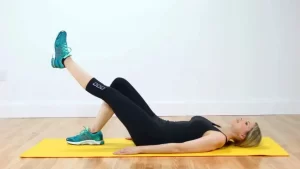
Static quadriceps exercise
- Laying or sitting on your back with support for your back, extend your legs straight in front of you.
- Place a little towel below your knee and twist it up.
- Pull the other foot toward you while moving the first one slightly to the side.
- As you firmly press your knee down, your muscles will contract.
- Hold this position for a few seconds.
- Then return to your neutral position.
- Then relax.
- Repeat this exercise 5 to 10 times.

Prone leg raise
- Instead of a hard surface, you can use a mat or a plinth to provide yourself some support during this exercise.
- Lying on your stomach.
- Extend your legs behind you.
- You can rest your head on your arms if it makes you uncomfortable.
- As you gradually contract your abdominal muscles, your knee should be straight.
- Then raise the left leg gradually in the direction of the roof.
- Hold your leg out straight in the air for a few seconds.
- Then lower your leg to the mat gradually.
- Then return to your neutral position.
- Then relax.
- Repeat this exercise 5 to 10 times.
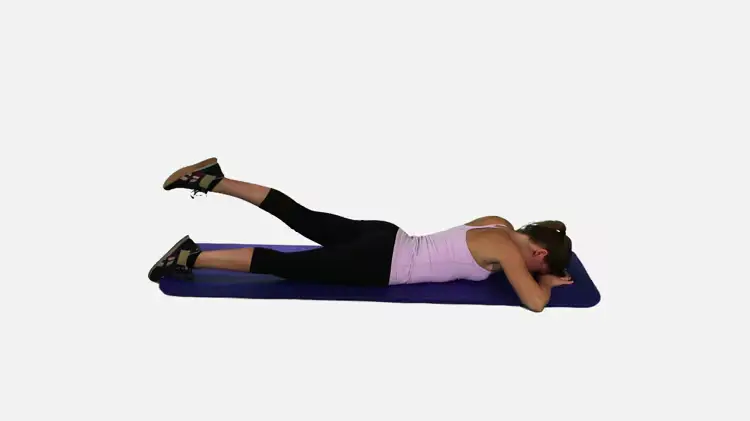
Standing Quadriceps Stretch
- Start on the floor in a comfortable standing position.
- Keeping it by your side, raise your left arm straight in front of your body.
- This helps with keeping things in balance.
- If the patient experiences difficulty with this exercise, they can modify it by grasping onto the back of a chair or wall.
- Bend to your left knee while holding onto your left ankle.
- Behind the body, place the left foot.
- With your hand on the ankle, attempt to move the leg up and back.
- Verify the proper alignment of your complete body.
- Hold this position for a few seconds.
- Then return to your neutral position.
- Then relax.
- Repeat this exercise 5 to 10 times.
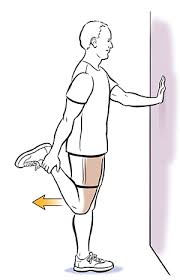
Lunge
- When standing, place your feet hip-width apart.
- Take a longer step forward than a walking step, placing one leg in front of your body and the other behind.
- When your foot touches the ground, it should land and stay level.
- Your heel will come off the ground when you elevate it.
- Bend your knees to nearly a 90-degree.
- Remember to maintain your core engaged and your trunk upright.
- Hold this position for a few seconds.
- Then, to go back to the starting position, push off with force from your front leg.
- Then relax.
- Repeat this exercise 5 to 10 times.
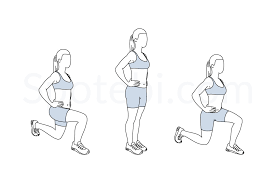
Standing calf stretch
- You must stand facing a wall to begin this stretching exercise.
- Stretch your arms out until your hands are comfortably pushing the wall.
- Place your hands at eye level.
- While maintaining the front leg bent, press the back (left) heel into the ground to straighten the back leg.
- Hold this position for a few seconds.
- Then return to your neutral position.
- Then relax.
- Repeat this exercise 5 to 10 times.
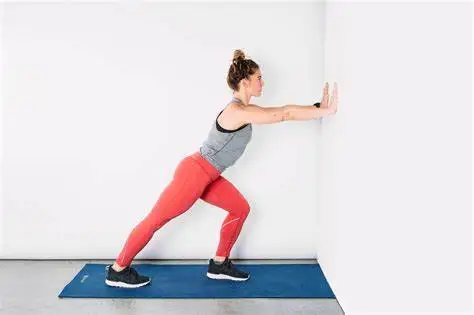
Step-ups
- Begin in a comfortable standing position.
- Place one at the base of a stairwell, a platform, or the foot of a step bench.
- Keep your height at your pelvic level.
- With the opposing foot, slowly lower yourself to the floor while bending at the knee.
- To take your spot, gently plant your toe on the ground and then stand back up.
- Then return to your neutral position.
- Then relax.
- Repeat this exercise 5 to 10 times.

Clamshell
- You begin by lying on your side.
- Bend your elbow while lying on your left side.
- Support your head with your left hand.
- Place your right foot and leg on top of your left, bending your knees to a 45-degree angle.
- For balance, rest your right hand on your hip or lightly on the ground in front of you.
- Next, slowly elevate your right knee toward the sky while keeping your feet close to the ground.
- Keeping your core strong, raise your lower right leg back up to meet your left.
- Hold this position for a few seconds.
- Then return to your neutral position.
- Then relax.
- Repeat this exercise 5 to 10 times.
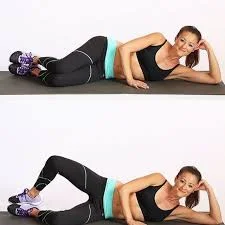
Donkey kick
- With your hands above your head, lie flat on the ground.
- Keep your hands closest to your shoulders while your legs under your hips.
- To maintain a flat back of the neck, lower your chin slightly and gaze downward and forth.
- Flex your right foot and maintain a 90-degree bend in your right leg to activate your glutes.
- Then, stretch your right leg upward and backward, toward the ceiling.
- Verify that your body height is slightly above the point at which your lower back is bent and your hips move or bend, as these are signs that you may have raised it too high.
- Maintain an upright, neutral back while keeping your hips parallel to the floor.
- Try not to rush your movements so that you can finish the exercise with a full range of motion and the proper technique.
- Lower your right leg first, and then raise it back up.
- Then return to your neutral position.
- Then relax.
- Repeat this exercise 5 to 10 times.
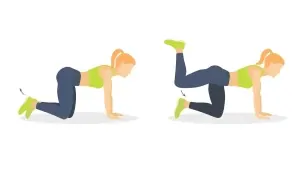
Hamstring Stretch
- Start with a relaxing lying down position on the ground.
- Now bend your one knee.
- Keep your hands behind your leg.
- Elevate one leg over the ground and raise it to your chest.
- Straighten your leg and raise it gradually.
- You can loop towels over your thigh if you have difficulty getting your hands behind your leg.
- Hold this position for a few seconds.
- Then return to your neutral position.
- Then relax.
- Repeat this exercise 5 to 10 times.

Wall slide
- Keep your back against the wall to start.
- Your feet should be shoulder-distance apart, and your heels should be about 6 inches in front of your hip line.
- Slide your back along the wall gradually until your knees are bent at a 45-degree.
- After about a few seconds, maintain this posture and get back up.
- Then return to your neutral position.
- Then relax.
- Repeat this exercise 5 to 10 times.
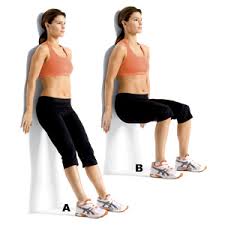
Standing Iliotibial band stretch
- Press firmly into both feet while standing with your right leg crossed in front of your left.
- As much as your body will allow, bend to the right and feel the stretch in your outer hip and knee.
- You can extend the stretch by raising your left arm above your head.
- If you want more stability or resistance, press your left hand into a wall.
- Hold this position for a few seconds.
- Stand up straight once more by uncrossing your legs.
- Then return to your neutral position.
- Then relax.
- Repeat this exercise 5 to 10 times.

Side-lying leg lift
- Laying on your right side with your feet positioned straight, extend your legs.
- The head should be rested on the right arm, bent, or kept straight.
- Keep your left hand forward for more support.
- Gently move the left leg off the right leg.
- Hold this position for a few seconds.
- Slowly lower your leg.
- Then return to your neutral position.
- Then relax.
- Repeat this exercise 5 to 10 times.
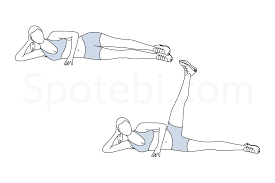
Bridge kick
- Lying on your back, bend your knees toward the sky and keep your arms at your sides.
- Lift your back off the ground.
- Move your weight to your left foot and slowly lift it off the ground until your right leg is at a 45-degree angle.
- Keep your knee from locking.
- Hold this position for a few seconds.
- Without stepping on it, put the right foot back on the ground.
- Then return to your neutral position.
- Then relax.
- Repeat this exercise 5 to 10 times.
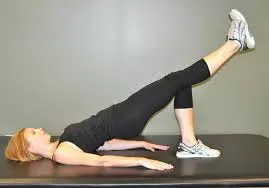
Single-leg Romanian deadlift
- Standing, position your feet shoulder-width wide.
- Place your weight on your left leg and flex your left knee just a little bit.
- Maintaining your left arm straight at your side, bend (hinge) forward from your hip.
- Stretch your right arm toward the floor while your right leg rises off the ground and back up.
- Your upper torso should be nearly parallel to the ground. (For a more difficult exercise, extend your hand toward the floor while holding a dumbbell or kettlebell.)
- Then relax.
- Repeat this exercise 5 to 10 times.
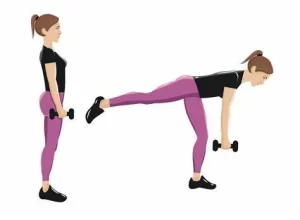
Lying hamstring curl with dumbell
- One dumbbell should be positioned vertically on the floor, with one foot on either side of it.
- Put your hands and elbows beside your head, or place your hands on your head, as you lower yourself into a prone posture.
- Activate your glutes.
- As you elevate off the floor toward your glutes, flex your feet, squeeze the dumbbell with your feet, and bend your knees to contract your hamstrings and glutes equally.
- Hold this position for a few seconds.
- As you go down back down, continue to use your legs and glutes.
- Then return to your neutral position.
- Then relax.
- Repeat this exercise 5 to 10 times.

Lateral band walk
- Hold a hip-width gap between your feet
- Use a Thera-band just above your knees.
- After lowering yourself into a running stance, take a step to the left.
- Continue moving left in little steps, then repeat to the right.
- Then return to your neutral position.
- Then relax.
- Repeat this exercise 5 to 10 times.

Leg extensions
- Sit up straight in a long chair and place your leg on the floor to start.
- Tighten your thigh muscles, face forward, and raise one leg as high as you can to build strength without getting off the chair.
- Hold this position for a few seconds.
- Gently lower your leg.
- Then return to your neutral position.
- Then relax.
- Repeat this exercise 5 to 10 times.
When exercising, what safety precautions need to be taken?
- Maintain proper posture during the exercise.
- Extend, hold, and repeat the exercise correctly.
- Avoid uncomfortable routines for exercise.
- Avoid doing exercises that hurt.
- Stop exercising if an unexpected ache develops.
- In between sets of exercises, rest.
- When exercising out, wear loose clothing to allow for easy movement of your body.
- Stretch the muscles if they feel stiff, but never feel severe or intense pain.
When should you stop exercising?
- Muscular burning that is intense
- Fever
- If you feel any discomfort or numbness.
- If exercise causes pain, stop.
- Headache
Which exercises have to be avoided if you have a runner’s knee?
- Don’t engage in high-impact sports like kickboxing, jogging, or running.
- Avoid exercises such as deep squats and complete lunges. Your knee muscles will be under a lot of stress as a result.
- Avoid performing complete squats.
- A side plank exercise should be avoided since it could strain the knee joint.
- Avoid fully extending your legs; it could harm your knees. You can elevate your leg halfway up instead of fully extended if you would prefer to execute a modified version of this exercise.
- Stay away from excessive knee flexion.
Advice for preventing runner’s knee:
Although the runner’s knee pain cannot be completely avoided, the following measures can help reduce symptoms.
- Reduce your high-impact exercise program.
- Combine low-impact or non-impact workouts, such as yoga and swimming, with your jogging days.
- Increase intensity and mileage gradually. Running too quickly and for extended distances might cause knee pain.
- Maintaining a healthy lifestyle and being overweight places additional strain on the knee joint when exercising. Consult your doctor about the weight loss plan.
- Regular stretching before an exercise could help you avoid developing knee pain.
- Select weightless shoes. You may require more supportive shoes or orthotic inserts. Every 400 to 600 kilometers, athletes should also update their shoes. Make sure the athletic shoes you wear fit and support your feet correctly.
- Before working out, remember to warm up and perform dynamic stretching.
How much time does it take to recover?
Rest is necessary for the runner’s knee pain to go away. You might need to take a break from athletics or stop completely until you feel better. Stay away from any additional activities that worsen your pain, such as climbing and descending stairs. Everybody recovers from a runner’s knee differently. In two to three weeks, your pain should go away with rest and ice.
Alternatively, you might need to contact a physical therapist who can help you resume jogging by guiding you through strengthening and stretching activities. If, after three weeks, your knee pain does not improve, contact a physician. An MRI, CT scan, or X-ray may be ordered to identify the cause of your pain.
Summary:
Many runners will have knee pain at some point. A runner’s knee is a common reason for knee pain among runners. There are a variety of treatments for this condition, but strengthening exercises are one of the most successful components of any rehabilitation program.
You should probably limit your running and other athletic activities until your runner’s knee pain goes away. However, you might still be able to engage in other low-impact sports like cycling and swimming.
Consult a physician if your knee pain doesn’t improve after a few weeks. To find out what’s causing your pain, you could require an MRI, CT scan, or X-ray.
FAQ:
How do you treat an injured knee?
Place a pillow behind your leg to give your knee some much-needed rest while it’s elevated. To relieve pain and swelling, use an ice pack over the knee. Wrap your knee with a crape bandage or brace for support. As needed, take diclofenac or ibuprofen to ease discomfort. Perform some stretching and strengthening exercises, paying particular attention to your quadriceps muscles.
Can I work out while wearing a runner’s knee brace?
Treating a runner’s knee injury requires addressing its underlying cause. You should be able to start exercising again as the soreness subsides. Of course, if you make a mistake during your training, such as increasing your training too quickly, you should resume training with more caution.
What is the term for a runner’s knee?
Usually, the area behind or close to the kneecap is affected by the anterior component of the knee pain. Consequently, medical professionals call it patellofemoral pain or patellofemoral pain syndrome (PFPS). Because it affects the region between the patella (kneecap) and the thighbone (femur), it is known as patellofemoral.
Does the runner’s knee heal completely?
Patellofemoral Pain Syndrome (PFPS), also known as “runner’s knee,” is a frequent overuse condition that can affect bikers, walkers, hikers, soccer players, and runners. Runner’s Knee typically goes away entirely in a few weeks, but if treatment is not received, it can develop into a chronic condition.
Can someone with a runner’s knee walk?
Avoid high-impact sports and keep yourself active with walks and riding. Start with several shorter runs to ease yourself back into running until you can run pain-free and comfortably once your pain has gone away and you can sit, climb down stairs, and squat without experiencing any pain.
What would happen if a runner’s knee was ignored?
With the runner’s knee, “knee damage” and further knee surgery are not usually necessary. However, you should not to ignore pain since it could lead to severe knee damage that would prevent you from continuing on the route.
Are runners’ knees improved by yoga?
It is worth noting that a well-rounded yoga practice targeted to the demands of runners has not only helped many people avoid such ailments but also helped countless others recover from the kind of knee injuries that are reported.
Does the runner’s knee improve with stretching?
The best runner’s knee exercises should to include both stretching and strengthening. Exercises that focus on strengthening the knee, hip, and thigh muscles are recommended. This comprises the hip abductor and rotator muscles as well as the quadriceps located at the front of the thigh.
Can you perform daily knee exercises?
Doing little tasks throughout the day is beneficial. As a guide, practice your repetitions once every hour. Every few days, increase the number of repetitions you do by one or two as things become simpler and if you feel capable.
Which muscles are used in the runner’s knee?
An individual may be more at risk for a runner’s knee if they have hamstrings, gastrocnemius (calf), iliotibial band (outside of thigh), or quadriceps that are especially tight.
Can someone with a runner’s knee climb?
With a runner’s knee, pain and stiffness are common, and it can be challenging to perform daily tasks like bending over or climbing stairs.
How is the runner’s knee prevented?
Your chances of developing a runner’s knee can be decreased by keeping your muscles strong and flexible, using good technique, and building up your mileage gradually. Take care of your body and keep hitting the ground to avoid letting this problem prevent you from reaching your running objectives.
Can someone with a runner’s knee lift weights?
Exercises for strengthening: By building up the surrounding muscles, it is possible to stabilize and support the knee joint. Your primary focus should be on exercises that target the hamstrings, quadriceps, and calves. Consult a physical therapist to design a safe, individualized strength-training program for your condition.
References:
- On April 17, 2023b, Donohue, M. Knee of a runner. The website Healthline provides information on runners’ knee care.
- Pt. B. S. (2022, 26 May). A Patellofemoral Syndrome Exercise Program. Verywell Medical. PT exercises for runners’ knees (2696583) in https://www.verywellhealth.com
- December 13, 2023b; Tirgar, P. Mobile Physio Clinic: 13 Greatest Runner’s Knee Exercises. Mobile Clinic for Physiotherapy. Here are the top 13 knee exercises for runners: https://mobilephysiotherapyclinic.in/
- Exercises To Strengthen Your Knees While Running | Central Gymshark. (n.d.). Knee strengthening exercises for runners: https://central.gymshark.com/article
- June 4, 2023b; Cp, C., & Cp, C. Which Exercises Are Good for Runner’s Knee? • The Core Function. On the website of Central Performance, there is a publication titled ” In What Ways to Treat and Avoid Runners’ Knee Pain: Which Strength Exercises Would You Do?”
- July 30, 2020: Rdn, L. A. Are You Having Trouble with Cardio? 11 Exercises for Pain Relief from Runner’s Knee. Greatist. https://greatist.com/health/exercises-and-stretches/runners-kneeexercices
- Image 1, Wellness. (October 25, 2013). Raise Your Legs Straight [Video]. https://www.youtube.com/watch?v=qvi8aM02_GY
- Image 13, Kick and Bridge (n.d.). Bridge Kick: https://spineandsportspt.org/exercises/
- Image 15, October 13, 2016 / Cassie. Pinterest – Knee-friendly work-outs for strengthening hamstrings, page 2. /pin/knee friendly-workouts-for-firming-up-hamstrings-page-2–2512171040283540/



